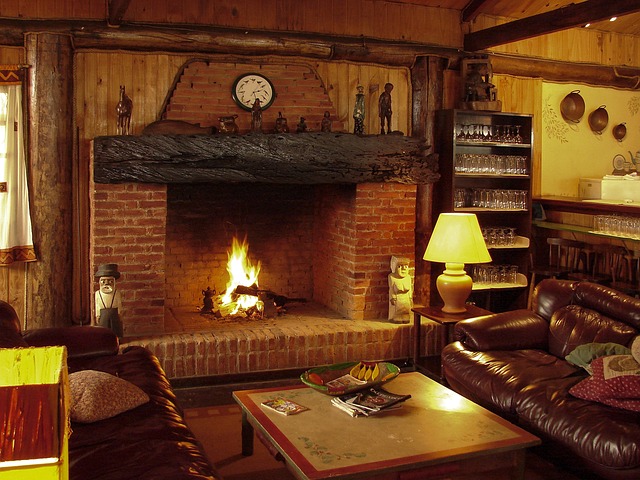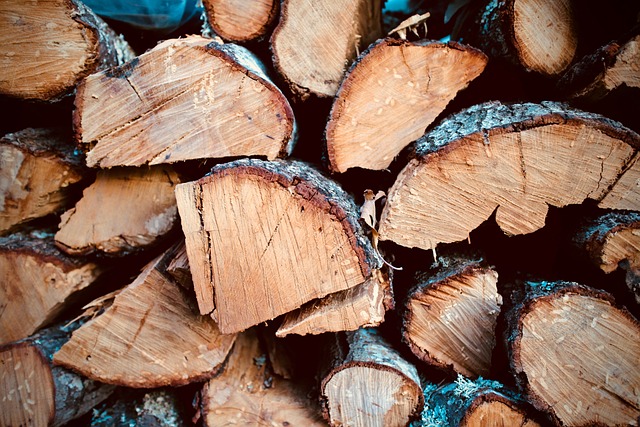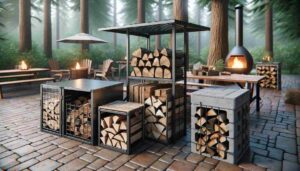Have you ever gathered around a crackling fire on a chilly evening, enjoying its warmth and cozy ambiance? As a fellow firewood enthusiast, I’ve often found myself pondering the question: Is oak good firewood?
And the answer is yes, oak is considered excellent firewood. It produces high heat, burns slowly, and creates long-lasting embers. Its density and coaling properties make it a reliable choice for heating.
However, it’s essential to approach firewood selection with a discerning eye. I’ll explore considerations such as availability and cost, as well as proper storage techniques to maintain the quality of your oak firewood. I’ll also address the challenge of igniting oak and the precautions to take due to its tendency to produce sparks.
Oak, renowned for its strength and durability, has been a popular choice among firewood enthusiasts for centuries. But what makes oak such a sought-after option? Is it truly the right fit for your fireplace or wood-burning stove?
In this guide, I’ll explore its qualities, benefits, and considerations to help you make an informed decision for your own fireside experiences. Let’s get started!
Understanding Oak Firewood
When it comes to firewood, oak holds a special place in the hearts of many fire enthusiasts. Its reputation as a reliable and versatile option has been earned through centuries of use. So, let’s take a closer look at what makes oak an excellent choice for your fireside needs.
- Oak as a popular firewood choice:
- Oak has been used as firewood for generations due to its desirable burning characteristics.
- Its dense nature and slow-burning properties make it a favorite among those seeking long-lasting heat.
- Common oak varieties used for firewood:
- There are several oak species used for firewood, including white oak, red oak, and post oak, among others.
- Each variety has its own unique qualities, but all share the general characteristics that make oak a reliable firewood choice.
- The dense nature and slow-burning characteristics of oak:
- Oak is known for its high density, which contributes to its slow and steady burn.
- The density of oak wood allows it to release a consistent and long-lasting heat output, keeping your space warm for extended periods.
- Comparing oak to other firewood options:
- Oak’s density sets it apart from softer woods like pine or poplar, which burn quickly and provide less sustained heat.
- While oak may take longer to ignite compared to softer woods, its superior burning qualities make it worth the initial effort.
- Moisture content and seasoning:
- Like all firewood, oak needs to be properly seasoned to ensure optimal burning efficiency.
- Freshly cut oak contains a high moisture content, so it’s crucial to allow it enough time to dry and reach the ideal moisture level for burning.
- Proper seasoning not only enhances the heat output but also reduces the amount of smoke and creosote buildup in your chimney.
In the next section, I’ll delve into the advantages of using oak as your primary firewood choice.
The Benefits of Oak Firewood
When it comes to choosing firewood, oak stands tall among the options available. Its numerous benefits make it a preferred choice for those seeking a reliable and efficient source of heat. Let’s explore the advantages of using oak firewood:
- High heat output:
- Oak is renowned for its ability to produce intense heat. Its dense composition allows it to generate a substantial amount of warmth, making it ideal for heating larger spaces or during cold winter nights.
- The high heat output of oak ensures that you can create a cozy and inviting atmosphere in your home.
- Extended burn time:
- Oak’s density not only contributes to its high heat output but also enables it to burn for a longer duration compared to softer woods.
- With oak firewood, you can enjoy a sustained fire, reducing the need for frequent refueling and providing continuous warmth throughout the evening.
- Excellent coaling properties:
- Oak produces hot embers that remain burning for a significant period. These red-hot coals are valuable for maintaining a steady fire overnight or rekindling the flames the next morning.
- The coaling properties of oak contribute to its overall efficiency and reduce the need for constant tending and log replacement.
- Seasoning qualities:
- Oak has a relatively quick drying time compared to other hardwoods. This means that it can be seasoned and ready for use in a shorter period.
- Properly seasoned oak firewood burns more efficiently, producing less smoke and increasing its overall heat output.
- Pleasant aroma:
- When oak burns, it emits a pleasant and distinctive aroma that adds to the ambiance of your fireplace or wood-burning stove.
- The aromatic qualities of oak create a delightful sensory experience, enhancing your enjoyment of fireside moments.
These advantages make oak a reliable and satisfying option for keeping your home warm and cozy. However, it’s essential to consider a few factors before deciding if oak is the right choice for you.
Considerations for Using Oak Firewood
While oak firewood offers numerous benefits, it’s important to be aware of certain considerations before making it your primary choice. By understanding these factors, you can make an informed decision and ensure a positive firewood experience. Let’s explore the key considerations when using oak firewood:
- Availability and cost:
- The availability of oak firewood can vary depending on your location. In some areas, oak may be abundant and readily accessible, while in others, it may be harder to find.
- Additionally, oak firewood tends to be more expensive compared to softer woods due to its superior burning qualities and higher demand. Consider your budget and availability when choosing oak.
- Proper storage:
- Like any firewood, oak requires proper storage to maintain its quality. It’s essential to store oak firewood in a dry, well-ventilated area, such as a woodshed or covered storage rack.
- Elevate the firewood off the ground to prevent moisture absorption and allow air circulation to promote proper drying and seasoning.
- Slow ignition:
- Oak can be more challenging to ignite compared to softer woods due to its density. To start a fire with oak, it’s recommended to use effective kindling, such as small twigs, newspaper, or fire starters, to create a strong initial flame.
- Patience and persistence are key when starting a fire with oak. Once it ignites, its reliable burning qualities will reward you with sustained warmth.
- Potential sparks:
- Oak firewood has a tendency to produce sparks, especially when it’s not properly seasoned or contains high moisture content.
- To mitigate the risk of sparks causing accidents or damaging your surroundings, consider using a spark arrestor screen or ensuring your fireplace or wood-burning stove is equipped with appropriate safety features.
Remember to assess the availability, cost, proper storage, ignition techniques, and precautions against sparks to ensure a satisfying fireside experience.
In addition to its use as firewood, oak offers alternative benefits in various realms. In the next section, I’ll explore some exciting alternative uses for oak firewood beyond mere heating purposes.
Alternative Uses for Oak Firewood
While oak firewood is primarily valued for its excellent burning qualities, it also has alternative uses that extend beyond providing warmth. Let’s explore some exciting ways you can make the most of your oak firewood:
- Cooking and grilling:
- Oak firewood is highly sought after for its ability to impart a rich, smoky flavor to grilled or barbecued food.
- Many grilling enthusiasts prefer oak for smoking meats, as it adds a distinctive taste that enhances the overall flavor profile.
- Consider using oak firewood chunks or chips in your charcoal or wood pellet grill to infuse your favorite dishes with that delicious smokiness.
- Woodworking and crafts:
- Oak is a beloved choice among woodworkers and craftsmen due to its durability, strength, and beautiful grain patterns.
- If you have woodworking skills or enjoy DIY projects, oak firewood can be repurposed into stunning furniture, decorative items, or even unique gifts.
- Explore the world of woodworking and unleash your creativity by transforming oak firewood into functional and aesthetically pleasing pieces.
Whether you’re savoring the flavor of grilled delicacies or channeling your inner artisan through woodworking, oak firewood opens up new possibilities.
Why does oak not burn well?
Oak is generally considered to burn well, but there are a few factors that can make it appear as if it doesn’t burn as easily as softer woods. Here are 4 reasons why oak may seem challenging to ignite or burn:
- Density: Oak is a dense hardwood, which means it has a higher mass and tighter cell structure compared to softer woods like pine or poplar. This density can make it more difficult to ignite because it takes longer for the heat to penetrate the wood and initiate the combustion process.
- Moisture Content: Freshly cut oak typically has a higher moisture content than seasoned firewood. High moisture content makes it harder to ignite because energy from the fire is initially absorbed by the water within the wood. It’s important to properly season oak firewood, allowing it to dry and reach the optimal moisture level for efficient burning.
- Ignition Techniques: Oak may require more effort and patience when it comes to ignition techniques. To successfully ignite oak firewood, it’s recommended to use effective kindling, such as small twigs, newspaper, or fire starters, to create a strong initial flame. Ensuring good airflow and using proper fire-starting techniques can help overcome the challenges of ignition.
- Spark Production: Oak has a tendency to produce sparks when burning, especially if it’s not properly seasoned or contains high moisture content. While the sparks themselves are not necessarily a sign of poor burn quality, they can be a concern for safety. It’s important to take necessary precautions and use spark arrestor screens or other safety measures to prevent sparks from causing accidents or damage.
Despite these considerations, oak is still regarded as a high-quality firewood due to its dense nature, long burn time, and high heat output once it is successfully ignited. With proper seasoning, ignition techniques, and safety precautions, oak can provide you with a reliable and satisfying fireside experience.
How long does it take oak to dry for firewood?
The drying time for oak firewood can vary depending on several factors, including the initial moisture content of the wood, the climate and weather conditions, and the specific drying method used. However, as a general guideline, oak firewood typically takes about 6 to 12 months to properly dry and reach the optimal moisture level for efficient burning.
When freshly cut, oak can have a moisture content of around 50% or higher, which is too high for effective burning. To reduce the moisture content and ensure the wood is properly seasoned, it needs to be stored and allowed to dry.
Here are some factors that can affect the drying time of oak firewood:
- Splitting: Splitting the oak logs into smaller pieces increases the surface area exposed to air, which helps facilitate the drying process. Smaller split pieces will generally dry faster than larger logs.
- Air circulation: Proper airflow is crucial for drying firewood. Stack the split oak logs in a way that allows air to circulate freely around them. Avoid stacking the wood too tightly or covering it completely, as this can hinder drying.
- Shelter and sunlight: While oak firewood needs to be protected from excessive rain or snow, it benefits from some exposure to sunlight and natural airflow. A covered woodshed or stack with open sides can provide protection while still allowing the wood to receive sunlight and airflow.
- Climate and weather conditions: The drying time can be influenced by the climate in your region. In drier and warmer climates, oak may dry faster compared to areas with high humidity or colder, wetter weather.
As a general rule, it’s recommended to give oak firewood at least 6 to 12 months of drying time. However, it’s essential to check the moisture content of the wood using a moisture meter before using it as firewood. The optimal moisture content for burning is typically around 20% or less.
Properly seasoned oak firewood will burn more efficiently, produce less smoke, and generate more heat. Taking the time to ensure the oak is adequately dried will result in a more satisfying fireside experience.

Is oak OK to burn in a fireplace?
Yes, oak is generally considered an excellent choice for burning in a fireplace. It has several qualities that make it well-suited for this purpose:
- High heat output: Oak produces a significant amount of heat when burned, making it effective at warming up a room and providing a cozy ambiance.
- Long burn time: Due to its density, oak burns slowly and steadily. This means you won’t need to constantly add more logs to maintain the fire, allowing for longer periods of uninterrupted warmth.
- Coaling properties: Oak creates hot and long-lasting embers, known as coals, which help maintain a consistent fire. These coals can provide sustained heat even after the flames have subsided, allowing for extended warmth throughout the night.
- Pleasant aroma: Oak has a distinctive and pleasant aroma when burned, adding to the overall sensory experience of sitting by a fireplace.
However, it’s important to note a few considerations when burning oak in a fireplace:
- Proper seasoning: Like any firewood, oak should be properly seasoned before use. Freshly cut oak contains a higher moisture content, which can hinder its ability to burn efficiently and create excess smoke. It’s crucial to allow oak firewood enough time to dry and reach the optimal moisture level for efficient burning.
- Adequate airflow: Ensure that your fireplace has proper ventilation and airflow to allow the oak firewood to burn efficiently. Good airflow helps with complete combustion and reduces the risk of excessive smoke or buildup of creosote in the chimney.
- Safety precautions: As with any firewood, it’s important to follow safety precautions when burning oak in a fireplace. Use a screen or glass door to prevent sparks from escaping and always practice proper fireplace maintenance and chimney cleaning to reduce the risk of chimney fires.
It’s always a good idea to check local regulations and guidelines regarding the use of specific firewood types in your area to ensure compliance and safety.
Conclusion
In conclusion, oak firewood proves itself to be a reliable and beneficial choice for various reasons. Its high heat output, extended burn time, excellent coaling properties, and pleasant aroma make it a top contender for those seeking a consistent and enjoyable fireside experience. However, it’s important to consider factors like availability, cost, proper storage, slow ignition, and the potential for sparks before committing to oak as your primary firewood choice.
Moreover, oak firewood offers exciting alternative uses, including adding flavor to your culinary adventures and unleashing your creativity in woodworking projects. Embrace the multifaceted nature of oak firewood, allowing it to enhance not only your warmth but also your taste buds and craftsmanship.
So, the next time you gather around a crackling fire, contemplate the benefits and considerations of oak firewood. Whether you’re seeking warmth, flavor, or a creative outlet, oak firewood can be an excellent choice for your fireside needs. Embrace its qualities, be mindful of its considerations, and enjoy the countless delightful moments that oak firewood can bring to your life.
Related: Is Silver Maple Good Firewood? A Comprehensive Guide










